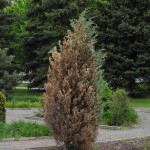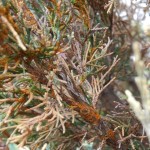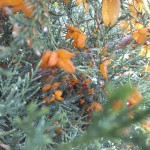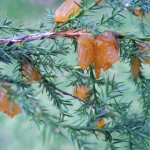Quince Rust on Junipers
Another rust disease in the cedar rust group, quince rust is the most likely to cause serious dieback on junipers.
- Upright blue juniper with dieback from quince rust.
- Orange rust gall lesions on affected juniper.
- Nearby hawthorn trees visible at the left of this image.
With this disease the bright orange “galls” are actually just slightly swollen lesions on the stems. Widespread lesions can lead to significant browning of the branch tips as pictured above. Spores which spread from these galls in the spring infect the alternate hosts of quince, hawthorn, crabapple or apple tree leaves. On hawthorn trees this disease causes causes symptoms on the leaves, white fringes on the fruit and swellings and distortion of the branch tips.
As with similar rust diseases separating the juniper from the alternate host (the further apart the better) can help keep this disease in check.
For lists of resistant varieties and fungicides labeled for managing this disease refer to the Disease Section of Cornell Guidelines for Commercial Production and Maintenance of Trees and Shrubs.





